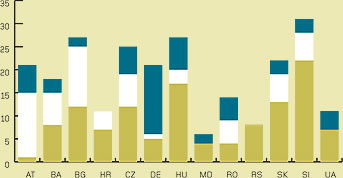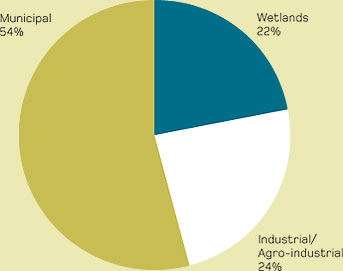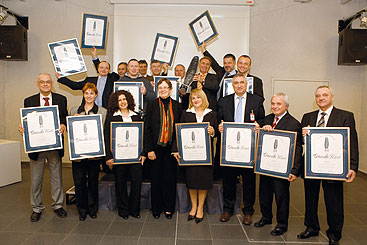
The ICPDR Joint Action Programme 2001-2005
The final report of the Joint Action Programme details the achievements that have been made by the Danube countries to make a positive difference to the aquatic environment along the Danube and its tributaries in the period 2001-2005.

The final report on the Joint Action Programme gave Danube countries reason to celebrate as the information details the progress made throughout the basin on everything from pollution and floodplain restoration to water quality standards.
In 2007, the ICPDR completed the final report on the implementation of the joint action Programme (JAP). The report summarises achievements that have been realised through the work of countries under the ICPDR and the strategy for implementation of the danube River Protection Convention (DRPC) up to 2006. The JAP adopted by the ICPDR in 2000 focused on pollution from point and diffuse sources, wetland and floodplain restoration, reduction and control of priority substances, water quality standards, prevention of accidental pollution, flood prevention and control and river basin management. Particular attention was given to both structural/investment and non-structural/policy reforms measures that address nutrient reduction and protection of transboundary waters and ecosystems.
The total investment foreseen in the JAP period 2001–2005 to respond to priority needs is estimated to be about €3.9 billion. Of this, municipal waste water collection and treatment plants amounts to €3.5 billion, industrial waste water treatment amounts to €296 million, agricultural projects and land use amounts to €113 million and rehabilitation of wetlands amounts to €224 million.
Achievements of the countries in the Danube River Basin. In the frame of the ICPDR Joint Action Programme, 251 committed investment projects and strategic measures have been identified out of which 140 are in the municipal sector, 56 in the industrial sector and 55 for floodplain/wetland restoration. Most of these projects, listed generally as ‘hot spots’ or point sources of emission, represent national priorities and take into account the obligation to mitigate transboundary effects.
The largest number of municipal projects has been realised by Hungary and Slovenia. Germany achieved the largest number of wetlands rehabilitation measures, while Austria leads with the largest number of industrial and agro-industrial measures. “The results show that some countries (Austria, Slovakia and Slovenia) have completed or even exceeded the 2000 commitments,” says Joachim Heidemeier, Chairperson of the Pressures and Measures Expert Group of the ICPDR. “Some have fulfilled all commitments within one sector.”
A considerable amount of pollution reduction has been achieved through the implementation of 130 municipal wastewater projects. Annual reductions of more than 198,000 tonnes of Biological Oxygen Demand (BOD), nearly 32,000 tons of total nitrogen, and approximately 11,000 tonnes of total phosphorus are estimated.
NUMBER OF INVESTMENT PROJECTS ACHIEVED
PER COUNTRY (2001-2006)

Introducing policies and legal instruments. Commitment to EU directives has been central to success and this commitment must continue to be fostered throughout implementation of the EU Water Framework Directive (WFD). Danube countries faced substantial challenges in establishing and strengthening the policy and institutional framework. Today, progress can be reported with all Danube countries in redesigning policies, programmes and regulations, in establishing appropriate incentive structures, redefining partnerships with stakeholders and strengthening financial sustainability of environmental services. Still, the key policy challenge Danube countries face is to identify the most effective ways of implementing EU environmental directives.
Most Danube countries have functional institutional administrative structures at the central and regional or local level with clear responsibilities. Inter-ministerial structures exist at the national level, which ensures intersectoral coherence and complements in the application of laws and regulations. Investigations show that there is a need for changes or amendments to make institutions in some of the Danube countries more efficient and/or to avoid duplication of mandates and responsibilities in relation to water management and pollution control.
Still, the role of environmental authorities in most of the Danube countries at the local level needs to be strengthened by integrating environmental considerations into economic development.
SHARE OF THE NUMBER OF PROJECTS REALISED BY 2006 PER SECTOR IN THE DANUBE RIVER BASIN

Challenges for local water institutions. There is an increasing tendency of the local authorities in Danube countries to take more responsibility for environmental and water management strategies, due to their increasing role in national policy. Additionally, local water policies will have to consider the transboundary nature of the border rivers and the need to take measures and decisions together with neighbouring communities by implementing solutions at the local or regional scale wherever possible.
Still, the role of environmental authorities in most of the Danube countries at the local level needs to be strengthened by integrating environmental considerations into economic development. There are areas where the absence of adequate policy instruments and institutional capacity to support the monitoring of water use leads to increased service costs and the eventual deterioration of the resource and supporting service infrastructure.
Municipal projects. There has been an improvement in the water quality of Danube rivers since 1995, mainly due to the impact of the investment programme of the water industry and pollution control measures which have dealt with many point sources of pollution such as sewage systems, wastewater treatment plants, industrial sites and agricultural units. Two member states, Austria and Germany, have already implemented the Urban Waste Water Treatment Directive (UWWTD) and applied the nutrient removal. The other six member states are currently implementing the UWWTD in line with the transition periods agreed with the EC.
There are a total of 140 municipal wastewater sector projects amounting to €3.5 million. Many of the municipal sector improvements in Danube countries are only now starting to be realised. Tertiary treatment (nitrogen and phosphorus removal) is being applied for a large number of the upgraded and new wastewater treatment plants. Furthermore, demands for nitrogen and phosphorus removal for wastewater treatment plants in rural communities, representing approximately 40% of the Danube River Basin, are lower than for urban settlements.
International investments. Most of the investment in the wastewater sector has been made in the countries that joined the EU in 2004: the Czech Republic, Hungary, Slovakia and Slovenia. A large proportion of project financing for these investments came from local or national sources. The DABLAS Task Force is a platform for cooperation on water protection and water-related ecosystems in the Danube and Black Sea Region to encourage a more strategic focus to the use of available financing, and to ensure coordinated action between all financial instruments operating in the region.
“Significant progress has been made in Romania”, says Gheorghe Constantin, Head of the Romanian Delegation to the ICPDR, “since the last DABLAS Task Force in 2004, and Bulgaria and Croatia have increased project preparatory efforts though they still lack financing.” Limited development in the wastewater sector has been achieved in downstream, non-EU countries, including Bosnia-Herzegovina, Serbia, Moldova and Ukraine.
International financing has been instrumental behind the development of the municipal wastewater sector in the Danube River Basin. EU grant financing has played a large role in funding several projects throughout the EU countries. The European Bank for Reconstruction and Development and the European Investment Bank have extended loans to municipalities for many of these projects, to help cover co-financing requirements. The World Bank–GEF Investment Fund has also participated in municipal wastewater projects, in addition to agricultural reform and other nutrient reduction efforts.
The presence of the EU, as a contracting party to the Danube Convention and an observer to the Black Sea Convention, helps guarantee success by tying concrete environmental achievements directly to the benefits of EU membership. Large infrastructure investment requirements are essential if countries are to meet EU standards. Overcoming these financial needs is a huge challenge for some lower Danube countries that have rather limited financial resources for investment with expenditure compared to upper and middle Danube countries.

The achievement of
the Danube countries
earned the attention
of the International
River Foundation (see
Editorial), as well as their
prestigious International
Thiess Riverprize. The
celebration of this award
brought representatives
of the Danube countries
together with Else
Shepherd, Vice Chair of
the International River
Foundation, in December
2007. The Heads of
Delegations were all
awarded diplomas for
their countries active
role in this remarkable
achievement.
Industrial projects. The degree of industrial
development and the importance
and amount of the pollution caused
by the industrial sector varies within
each country. Practically all industrial
branches are represented: chemical, electrical,
engineering works, metallurgical
and galvanic, textile, sugar, papermaking
and pulp-mills, wood-making industry,
etc. Still, in some cases industrial wastewater
is discharged into the public sewer
network without any or with insufficient
treatment. On the agricultural point
sources of pollution, pig and cattle farms
have been identified as point sources.
These hot spots are generally easy to
eliminate by treating the liquid manure.
In developing the Danube River Basin Management Plan, the ICPDR’s role is to encourage all the Danube countries to adopt and implement integrated pollution prevention and control legislation. The majority of the countries have a mandatory obligation to the EU while the remaining countries could be encouraged to adopt legislation requiring the application of best available technologies as basic measures in the Joint Programme of Measures.
Showing results. The JAP was a programme of the Danube countries mainly focused on the reduction of pollution. The results of the JAP show considerable success, many investments and actions are happening. Future actions in the Danube countries in implementing the DRPC should be thoroughly considered in relation to EU directives, in particular the EU Water Framework Directive, and integrated into the respective Joint Programme of Measures. The final implementation report provides a useful starting point for undertaking analysis related to and reporting on the implementation and effectiveness of policies in Danube countries. It shows that appropriate reporting is useful to better address and measure the policy responses within the future Joint Programme of Measures.
The implementation of the JAP raises a number of shared technical challenges for Danube countries. A common understanding and approach is crucial to the successful implementation of the DRPC and EU directives. “Sustainable development in the Danube River Basin requires continuous and enhanced international cooperation”, says Philip Weller, Executive Secretary of the ICPDR. “Success will depend on thorough implementation of actions and commitments of the countries and on the effective and coordinated contribution of the international community.” The ICPDR provides a forum for the dialogue, understanding and action needed to meet the challenges that exist.
For more information, please visit: www.icpdr.org/jap.
Disclaimer
The information contained in the ICPDR website is intended to enhance public access to information about the ICPDR and the Danube River. The information is correct to the best of the knowledge of the ICPDR Secretariat. If errors are brought to our attention we will try to correct them.
The ICPDR, expert group members, nor other parties involved in preparation of information contained on this website cannot, however, be held responsible for the correctness and validity of the data and information provided, nor accept responsibility or liability for damages or losses arising directly or indirectly from the use of the information conveyed therein.
Only those documents clearly marked ICPDR documents reflect the position of the ICPDR.
Any links to other websites are provided for your convenience only. The ICPDR does not accept any responsibility for the accuracy, availability, or appropriateness to the user's purposes, of any information or services on any other website.
When using the information and material provided on this website, credit should be given to the ICPDR.
